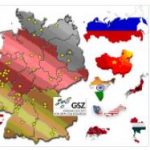The administration of the victors had to purge people, institutions, books from Nazi ideas, rigorously apply disarmament, restrict industry to narrow limits, organize the withdrawals of goods for repairs. Provisional borders attributed East Prussia to the Soviet Union, Silesia and the area up to the Oder, including Szczecin, to restored Poland. From these regions millions of refugees and expelled people flowed into the West, without means, aggravating the difficulties of the populations already experienced by the scarcity of housing and food. Denazification was carried out in a radical way, putting the functioning of schools, public offices, companies and factories in crisis. It had its culminating and spectacular moment in the Nuremberg trial to war criminals, that is, to the heads of Nazi organizations considered criminals (Gestapo, SS, Todt, etc.) and to members of Hitler’s governments. In the Soviet area it was applied with the discovery of the purpose of collectivizing agricultural properties, banks, companies, while in the West it was limited to impounding the Krupp workshops and the mines of the Saar, to break up the trusts. of the large steel, mechanical and chemical industries. At the same time, anti-Nazi democratic parties obtained authorization to reconstitute themselves: first from July 1945 in the Russian area, but united in an anti-fascist bloc led by the Communists; then also in the English and American areas with preferences for the Social Democrats; finally in December 1945 in the French one, with preferences for Christian-democratic currents. Thus different orientations were outlined in the different areas, while the admitted parties were given more place in the administration, even with the use of elections.
The victors were thus transforming themselves into friendly and allied forces. However, the US proposal (July 1946) to establish an economic unity between the four zones had been rejected by the Soviet Union and France. bizona, a German executive committee under which West Germany was admitted to the benefits of the Marshall Plan of reconstruction of Europe, which the Soviet Union had refused. In contrast, the Soviets had set up a similar commission in their area, also the draft of a German People’s Congress convened for December 1947. Meanwhile, a Saar Diet had decided on economic union with France. On March 19, 1948, the USSR responded to the new unitary cooperation bodies between the three Anglo-American and French zones by withdrawing its representatives from the Inter-Allied Control Commission in Berlin, thus putting an end to the four-party administration of Germany. The detachment of the two Germanys was accentuated: the access routes to Berlin were reduced, the Soviets organized a militarized German police in their sector; a monetary reform stabilized the western mark, that in Berlin it revealed its superiority over the eastern one, also reformed by the USSR; an assembly of representatives of theWestern Länder met to give a constitution to Germany. In contrast, in the East, a People’s Council was also drafting a Constitution for the whole of Germany: this while the test of strength of the blockade of Berlin was taking place, which was abandoned in May 1949 after 11 months. The “basic law of the Federal Republic of Germany”, drafted under the influence of the Christian-democratic leader Konrad Adenauer, he intended to avoid the negative experiences of the Weimar one. There were no longer any popular referendums, nor direct election of the president, nor emergency powers for the latter, nor his power to dissolve the Diet. To prevent overthrow of the government by inorganic opposition, only a “constructive vote of no confidence” was allowed, ie the election of a new government. Political parties would be admitted only if they recognized the democratic order (under Adenauer the Communist Party was declared illegal) and against the artificial formation of parties a quorum of 5% of the votes in a constituency was required for the votes to be added and given. rise to representation in the Diet. The Länder they were reconstituted and they were assured of greater influence through a Federal Council (Bundesrat) of their representatives. These Länder were very different from those of 1871 and 1919: Prussia was gone, Rhineland-Westphalia and Lower Saxony, including Hanover, were new creations. However, this Federal Republic counted 47,500,000 residents (8 million more than in 1939), excluded the territories annexed to Poland or occupied by the Soviet Union (one third of the old Reich) and the capital Berlin itself. In the Länder then there were different majorities, Social Democratic in some, Christian Democratic in others. In September 1949 the President of the Republic was elected by the Federal Diet in the person of a liberal historian, Theodor Heuss; he in turn proposed Adenauer as chancellor, who formed a coalition government of the CDU with the Bavarian liberals and Catholics. While the Allies continued to reserve competence over armaments, repairs, dismantling of industrial cartels, foreign policy, the major parties engaged in substantial democratic solidarity in reviving the economy. Public funding was provided for the reintegration of refugees from the East into the country; unemployment, aggravated by the influx of these refugees, was tackled with social measures and with aid from international funds.
According to programingplease, West Germany took another major step towards its reintegration as a sovereign state in 1950, when the NATO Councilhe accepted German participation in his unified forces of Europe. On this path, the federal government regained the active and passive right of diplomatic representation. In July 1951 the state of war of the Western powers with Germany ended, which was thus admitted into NATO; in this way the allied troops in West Germany lost the quality of occupying forces to assume that of allies. Within the framework of NATO, indeed with strong internal resistance, the remilitarization of Germany was also ratified by the Diet. The elections of 1953 gave over 45% of the votes to Adenauer’s party, which in the same year had made a remedial gesture by adhering to Israel’s request for compensation (one billion dollars) for the victims of Nazi anti-Semitism, and which had returned to the country, with economic prosperity, national sovereignty and an international position: neither Communists nor neo-Nazis had obtained any seats. The USSR itself renounced the exclusive recognition of the Democratic Republic of the East by establishing diplomatic agreements with Bonn, which however maintained an uncompromising position both with regard to East Germany and the Oder-Neisse line as a border with Poland. Strengthened by the absolute majority obtained in the 1957 elections, in which however a right-wing party fed by refugees was strengthened, Adenauer persisted in calling for the unification of Germany (Berlin, East Germany, German areas under Polish administration) on the basis of the self-determination of the peoples advocated by Moscow to UN for the colonial countries of Asia and Africa. Since 1949 the Soviet Union in its area had allowed, as a response to West Germany, the creation of a German Democratic Republic (Deutsche Demokratische Republik, DDR) under the presidency of a communist militant, W. Pieck, and with a socialist, O. Grotewohl, at the head of the government, a Christian Democrat and a Liberal vice-presidents. But a coalition government did not meet Moscow’s needs. Thus the GDR aligned itself with its 18 million residents (in addition to the eastern sector of Berlin with more than one and a half million) with the states of the communist bloc: Poland, Czechoslovakia, Hungary, recognizing the Oder line as the definitive border with Poland. -Neisse, in a treatise with it (1950). The GDR was recognized by all the Communist states: on the model of these it had established the dominance of a democratic bloc under Communist leadership that presented a single list of candidates in the elections. The new eastern mark, however, fell immediately below the official rate; ration restrictions persisted, foreign policy control was heavy and suspicious.








